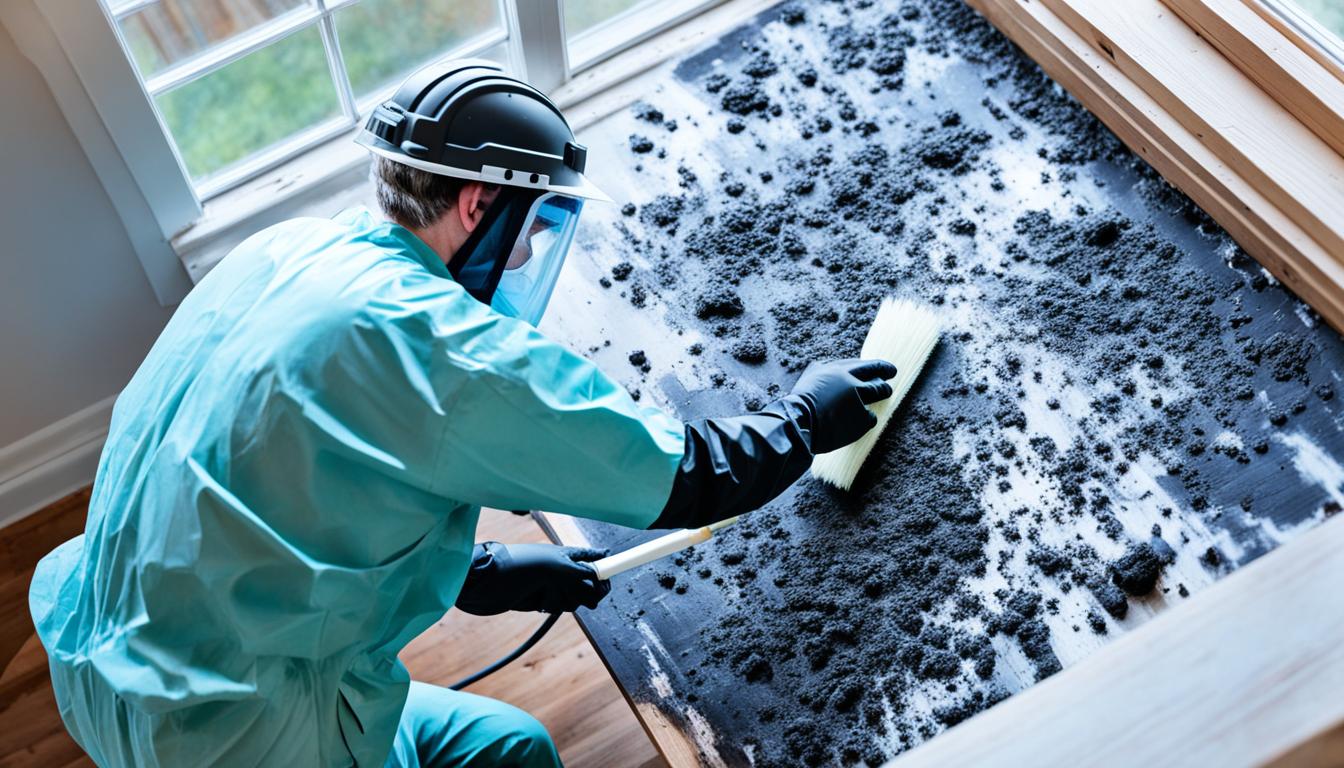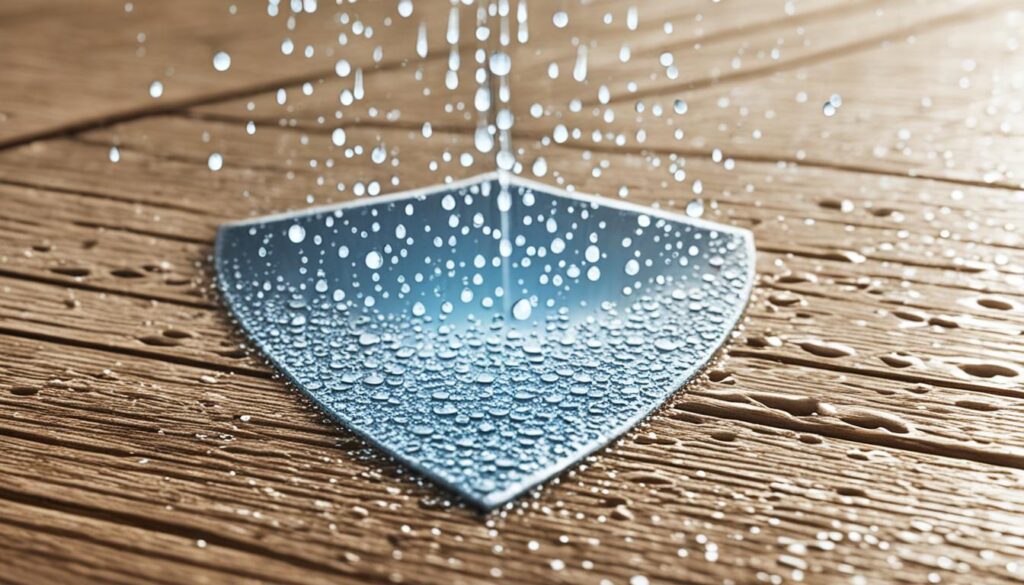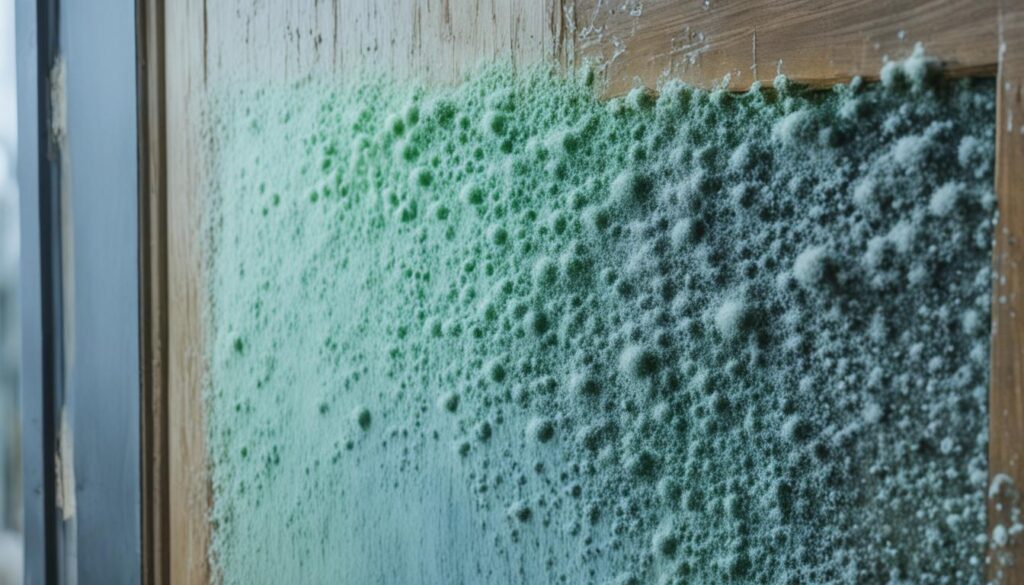
Eradicate Wood Mold: Proven Fixing Techniques
Wood mold can be a stubborn and persistent problem that needs immediate attention. If left untreated, it can not only damage the structural integrity of your wooden surfaces but also pose health risks to you and your loved ones. In this section, we will discuss effective techniques to fix mold on wood, including step-by-step methods for removing mold from wood and specialized mold remediation techniques designed specifically for wooden surfaces.
Key Takeaways:
- Properly identifying mold on wood is crucial before attempting any fixes.
- Safe removal of mold from wood requires appropriate protective gear and thorough cleaning techniques.
- Preventing mold on wood involves addressing moisture issues and implementing proactive measures.
- Treating mold on wooden surfaces may require additional steps, such as using specialized treatments or sealants.
- By following these proven fixing techniques, you can effectively eradicate mold on wood and ensure long-term mold prevention.
Identifying the Presence of Mold on Wood
Before we can effectively fix mold on wood, it is crucial to identify its presence. By recognizing the signs and symptoms of mold growth on wooden surfaces, you can take prompt action to address the issue. Let’s explore the key indicators that can help you determine if you have a mold problem on your wood:
- Visible Mold Growth: Look for any fuzzy patches, discoloration (often green, black, or white), or a powdery appearance on the surface of the wood. These visual cues are clear indications of mold growth.
- Musty Odor: Mold has a distinct musty smell similar to wet socks or a damp basement. If you detect this odor near your wooden surfaces, it could be a sign of mold presence.
- Water Damage: Keep an eye out for any areas on the wood that have experienced water damage, such as leaks, floods, or high humidity. Moisture provides an ideal environment for mold growth.
- Disintegration or Rotting: Mold can cause wood to disintegrate or rot over time. If you notice any soft, crumbling, or deteriorating sections of the wood, it could be due to mold infestation.
- Allergic Reactions: Mold can trigger allergic reactions in some individuals. If you or anyone in your household experiences unexplained allergy-like symptoms such as sneezing, coughing, watery eyes, or respiratory issues, mold on wood surfaces could be a possible cause.
By being vigilant and looking out for these signs, you can proactively identify the presence of mold on wood. This early detection will allow you to take appropriate measures to address the issue and prevent further damage.
“When it comes to mold on wood, it’s crucial to identify the problem early on. By recognizing the signs and symptoms of mold growth, you can take timely action to protect your wooden surfaces.”
Example of Visible Mold Growth on Wood:
| Signs of Mold on Wooden Surfaces | Description |
|---|---|
| Fuzzy patches or discoloration | Visible indications of mold growth on wood surfaces |
| Musty odor | A distinct smell often associated with mold presence |
| Water damage | Areas affected by leaks, floods, or high humidity |
| Disintegration or rotting | Wood deterioration caused by mold over time |
| Allergic reactions | Symptoms such as sneezing, coughing, and watery eyes |
Safe Removal of Mold from Wood
Once mold is identified on wood, it’s vital to take immediate action for safe and proper removal. Not only does mold compromise the structural integrity of wooden surfaces, but it also poses potential health risks. In this section, we will provide step-by-step instructions on how to effectively remove mold from wood, ensuring a clean and healthy environment for you and your loved ones.
Required Materials:
- Protective gear (gloves, goggles, mask)
- Plastic sheeting or drop cloths
- Scrub brush or sponge
- Mold-specific cleaner or a mixture of water and dish soap
- Hydrogen peroxide or white vinegar
- Clean cloth or towel
Step-by-Step Guide:
- Begin by ensuring proper ventilation in the area. Open windows and doors to allow fresh air circulation and prevent the spread of mold spores.
- Put on protective gear, including gloves, goggles, and a mask, to safeguard yourself from mold exposure.
- Cover the surrounding area with plastic sheeting or drop cloths to protect it from potential contamination during the removal process.
- Using a scrub brush or sponge, gently scrub the mold-infested wood surface to loosen the mold and remove any visible growth. Be sure to reach into crevices and corners where mold may hide.
- Prepare a mold-specific cleaner by following the instructions on the product label. Alternatively, create a mixture of water and dish soap for a homemade cleaning solution.
- Apply the cleaner or homemade solution to the affected wood using a clean cloth or sponge. Thoroughly saturate the mold-infested areas and leave the cleaner to penetrate the wood for a few minutes.
- After the recommended dwell time, scrub the wood surface again to remove any remaining mold. Rinse the cloth or sponge frequently and continue until all visible mold is gone.
- To further disinfect the wood and prevent mold regrowth, you can use hydrogen peroxide or white vinegar. Apply one of these agents to the cleaned surface and let it sit for at least 10 minutes.
- Finally, wipe the surface clean with a damp cloth or towel to remove any residue or cleaning solution.
- Dispose of any used cleaning materials and protective gear properly to prevent further contamination.
By following these step-by-step instructions, you can safely remove mold from wood surfaces and minimize the risk of further contamination. Remember to always prioritize safety and proper precautions during the mold removal process. If the mold infestation is severe or covers a large area, it’s recommended to seek professional assistance for safe and thorough mold remediation.
| Advantages of Safe Mold Removal from Wood | Dangers of Improper Mold Removal for Wooden Surfaces |
|---|---|
|
|
Preventing Mold on Wood
Once you have successfully removed mold from your wood surfaces, it’s essential to take proactive measures to prevent its return. Implementing preventive techniques can help ensure long-term protection for your wooden structures and furnishings.
Effective Mold Prevention Techniques for Wooden Surfaces
1. Maintain Proper Ventilation and Air Circulation:
Proper airflow is crucial in preventing mold growth on wood. Ensure that the rooms and areas with wooden surfaces are well-ventilated. Use fans or open windows to promote air circulation and reduce moisture accumulation.
2. Control Indoor Humidity Levels:
Excess moisture in indoor environments can lead to mold growth on wood. Aim to keep the humidity levels below 60%. Consider using dehumidifiers in rooms with high moisture, such as bathrooms and basements, to maintain optimal humidity levels.
3. Fix Leaks and Address Water Intrusions:
Leaking pipes, roof leaks, or any form of water intrusion can create the perfect environment for mold on wood. Regularly inspect your plumbing systems, roof, windows, and doors for any signs of leaks or water damage. Promptly address and fix any issues to prevent moisture buildup.
4. Ensure Proper Insulation:
Proper insulation can help prevent condensation and moisture buildup on wood surfaces. Insulate your walls, floors, and windows to minimize the risk of mold growth. Additionally, ensure proper ventilation in attics and crawl spaces to prevent excessive moisture accumulation.
5. Regularly Clean and Maintain Wood Surfaces:
Keep your wooden surfaces clean and free from dust, dirt, and debris by regularly dusting and wiping them down. This helps prevent the buildup of organic matter that can contribute to mold growth.
6. Apply Mold-Resistant Coatings:
Consider applying mold-resistant coatings or paints to your wooden surfaces. These products contain additives that inhibit mold growth, providing an extra layer of protection.
7. Promptly Address and Dry Wet Wood:
If your wood gets wet due to spills, leaks, or flooding, it’s crucial to address and dry it as soon as possible. Use fans, dehumidifiers, or natural ventilation to facilitate drying and prevent mold from taking hold.

By following these proven mold prevention techniques for wooden surfaces, you can safeguard your wood against future mold growth. Implement a regular maintenance routine and remain vigilant in monitoring moisture levels to ensure long-lasting protection for your valuable wooden structures.
| Key Steps for Mold Prevention on Wood | Details |
|---|---|
| Maintain Proper Ventilation and Air Circulation | Promote good airflow to minimize moisture buildup. |
| Control Indoor Humidity Levels | Keep humidity levels below 60% to prevent mold growth. |
| Fix Leaks and Address Water Intrusions | Regularly inspect and fix any water-related issues. |
| Ensure Proper Insulation | Properly insulate to prevent condensation and moisture. |
| Regularly Clean and Maintain Wood Surfaces | Keep wooden surfaces clean and free from organic matter. |
| Apply Mold-Resistant Coatings | Use coatings that inhibit mold growth on wood. |
| Promptly Address and Dry Wet Wood | Take immediate action to dry wet wood and prevent mold. |
Treating Mold on Wooden Surfaces
Sometimes, mold on wood surfaces may require additional treatment beyond removal. To ensure complete eradication and minimize the chances of reoccurrence, it is important to follow effective methods for treating mold on wooden surfaces. Here are some proven techniques:
- Use a Mold Treatment Solution: There are various mold treatment solutions available in the market specifically designed for wood. These solutions penetrate the wood, killing the mold and preventing future growth. Follow the instructions provided by the manufacturer and apply the solution to the affected areas.
- Sand and Seal: For mold that has deeply penetrated the wood, sanding the surface can help remove the mold-infested layer. After sanding, thoroughly clean the wood to remove any remaining mold spores. Once the wood is dry, apply a sealant to create a protective barrier against future mold growth.
- Heat Treatment: Applying heat to the mold-infested wood can effectively kill the mold. Use a heat gun or a hairdryer set to high temperature and direct the heat towards the affected areas. Be cautious not to overheat the wood, as it can cause damage.
Remember, proper ventilation and moisture control are essential in preventing mold growth on wooden surfaces. Keep the area well-ventilated and address any moisture issues promptly to avoid mold recurrence.

In the next section, we will conclude our discussion by summarizing the key points and emphasizing the importance of implementing effective mold removal and prevention techniques.
Conclusion
After learning about the various wood mold removal techniques and effective mold remediation for wood, it is clear that taking prompt action is crucial in eradicating mold on wooden surfaces. The step-by-step methods provided in this article offer practical solutions for addressing mold growth on wood, ensuring a safe and healthy environment.
Remember, when dealing with mold on wood, it is essential to identify the signs and symptoms accurately. Once identified, safely remove the mold using the recommended procedures to prevent further contamination or health risks. Additionally, implementing preventive measures is vital to avoid future mold growth on your wooden surfaces.
By following these recommended fixing techniques and maintaining a proactive approach, you can effectively eliminate mold on wood and ensure long-term mold prevention. Protect your wooden surfaces and create a healthier living environment by incorporating these practices into your maintenance routines.
FAQ
How do I fix mold on wood?
To fix mold on wood, start by identifying the affected areas and wearing protective gear. Scrub the mold-infested wood using a mixture of water and detergent. Rinse and dry the wood thoroughly. If the mold persists, consider sanding or using commercial mold removal products. Keep the area well-ventilated to prevent future mold growth.
What are some effective techniques for removing mold from wood?
Effective techniques for removing mold from wood include using a mixture of vinegar and water, hydrogen peroxide, or bleach solutions. Scrub the moldy wood surface with the chosen solution using a brush or sponge, ensuring to reach into crevices. Rinse thoroughly and dry the wood completely after cleaning.
How can I perform mold remediation for wood?
Mold remediation for wood involves removing and treating the affected areas. Wear protective gear, isolate the contaminated area, and make proper ventilation arrangements. Remove and dispose of any water-damaged or heavily infested wood. Clean the remaining wood surfaces using appropriate mold removal techniques, ensuring all mold is eradicated.
What are some ways to prevent mold on wood?
To prevent mold on wood, it’s important to control moisture levels. Keep indoor humidity below 50%, ensure proper ventilation, and address any water leaks or condensation issues promptly. Avoid direct contact between wood surfaces and damp areas, and consider using mold-resistant paints or coatings on wooden surfaces.
Are there any specific treatments for mold on wooden surfaces?
Yes, for severe mold infestations on wooden surfaces, professional treatments such as using fungicides or hiring mold remediation experts may be required. These specialized treatments ensure complete eradication of mold and prevent its reoccurrence. Consult with professionals to determine the most appropriate treatment for your specific situation.




